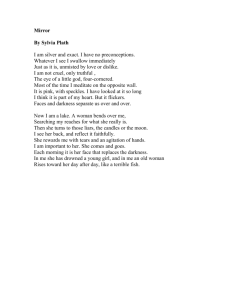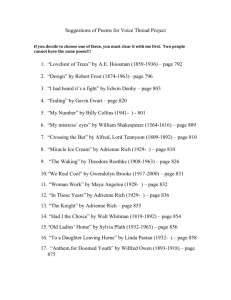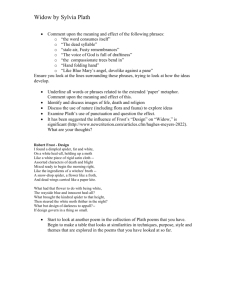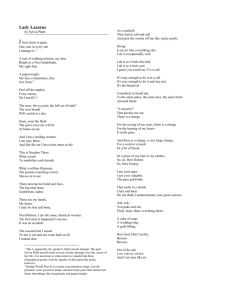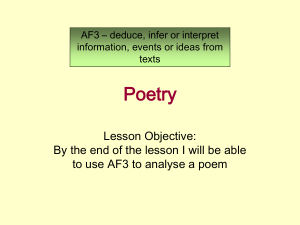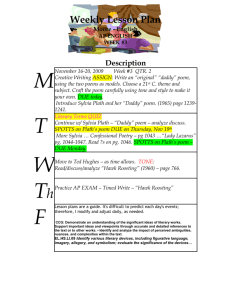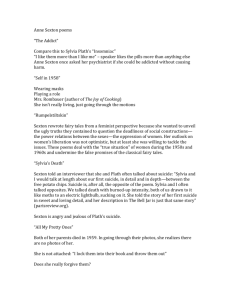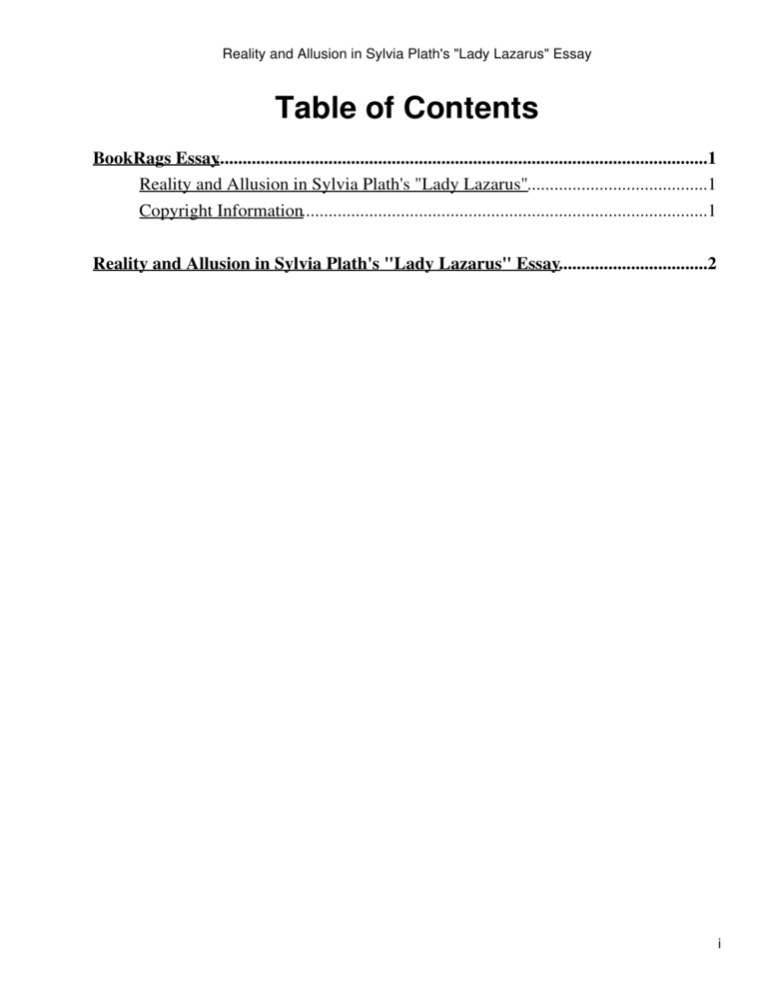
Reality and Allusion in Sylvia Plath's "Lady Lazarus" Essay
Table of Contents
BookRags Essay.............................................................................................................1
Reality and Allusion in Sylvia Plath's "Lady Lazarus"........................................1
Copyright Information..........................................................................................1
Reality and Allusion in Sylvia Plath's "Lady Lazarus" Essay.................................2
i
BookRags Essay
Reality and Allusion in Sylvia Plath's "Lady
Lazarus"
For the online version of Reality and Allusion in Sylvia Plath's "Lady Lazarus" Essay,
including complete copyright information, please visit:
http://www.bookrags.com/essay-2005/6/12/112016/705/
Copyright Information
(c)2000-2006 BookRags, Inc. ALL RIGHTS RESERVED.
BookRags Essay
1
Reality and Allusion in Sylvia Plath's
"Lady Lazarus" Essay
Reality and Allusion in Sylvia Plath's Lady Lazarus
Sylvia Plath completed her masterpiece, Lady Lazarus, in the days prior to her suicide
in 1963, while in a state of disturbance, distress, and obsession. To Plath, this was not
just a poem; rather a message to others about her life, her enemies, and her struggles
with everything from her family to mental stability. Lady Lazarus conveys Plath's real
life suicide attempts, parallels to her classic novel, The Bell Jar, as well as a biblical
allusion in its title, resulting in a horrific, yet detailed annotation of her psychological
troubles.
Within the first three lines of her autobiographical poem, Plath endows the reader with
a strong image and message, by simply stating she has attempted suicide three times.
Plath proclaims, "I have done it again. / One year in every ten / I manage it ----." She
is ultimately implying suicide attempts have plagued her at age ten, twenty, and thirty.
However, in real life, Sylvia Plath did not attempt suicide at age ten, but we are able to
deduce the fact that her father died when Sylvia was eight or nine years old. This
could possibly relate to suicide, because her soul died, and her father's death haunted
and upset her throughout her life. Plath also fails to further mention her first suicide
attempt at age 20, while she was a student at Smith College. As blatantly stated, Sylvia
Plath's mastery with these powerful tercets, creates vivid images, and entices the
reader from the first line.
The sixth stanza of Lady Lazarus speaks of Plath's second suicide attempt, which left
Plath almost paralyzed - mentally, emotionally, and physically. Stanza six of Lady
Lazarus reads:
Soon, soon the flesh
Reality and Allusion in Sylvia Plath's "Lady Lazarus" Essay
2
Reality and Allusion in Sylvia Plath's "Lady Lazarus" Essay
The grave cave ate will be
At home on me.
Plath creates a metaphorical image of being `swallowed up' by the "grave cave" as
well as portraying the concept of claustrophobia and being ensnared in a deep abyss.
Not only was this a horror and fear of Plath; it actually happened to her and Esther
Greenwood, the antagonist in her autobiographical fiction, The Bell Jar. In 1953, after
returning from McLean psychiatric hospital in Boston, Plath attempted suicide for the
second time in her life, by overdosing on a mélange of antidepressants and then hiding
in the crawl space, otherwise known as "the cave." Plath also ties in the line "The sour
breath will vanish by day" to this incident, because of body decomposition, her body
will no longer be around and her scents will vanish and be overcome by smells that are
more horrific.
Lines 25 through 27 are also in relation to Plath's 1953 suicide attempt because of the
news headlines Plath made when her mother found her unconscious and vomiting in
the basement crawl space, as well as the lengths that friends and family went to, in
order to find her. This is not the sole deduction that can be formed about line 25; it
also holds meaning to Plath's use of biblical allusion in the title. Plath predominantly
speaks of "a million filaments" and "the peanut crunching crowd." The "peanut
crunching crowd" is analogous to Plath's family members who were eager to aid in
searching for her upon her disappearance, as well as strangers who watched as the
event unfolded via the press and media, considering Plath's disappearance received
national attention. In the same respect the use of "a million filaments" can be related to
the flashbulbs of the reporters when the press flocked to Plath upon her discovery in
the crawl space and revival at McLean.
Plath speaks of her persona like that of a cat; she has nine times to die. In total, Plath's
suicide attempts numbered at three, and she was successful on the fourth, in which she
took her life by creating a gas chamber of sorts in the kitchen of her London flat. Plath
creatively uses the line, " What a trash / To annihilate each decade", to imply that she
Reality and Allusion in Sylvia Plath's "Lady Lazarus" Essay
3
Reality and Allusion in Sylvia Plath's "Lady Lazarus" Essay
has attempted suicide three times, once in each decade, first when she was 19, and
again at age 20 and 30. Thus, suicide and, moreover, the death of loved ones (her
mother and father), plagued each decade of her rather short life.
Plath's final unveiling of her own life's events and her chronicle of suicide can be seen
in stanza 14 when she utters the words:
As a sea shell.
They had to call and call
And pick the worms off me like sticky pearls.
This tercet portrays the grim experience that Plath describes in The Bell Jar, in which
Esther Greenwood (Plath) wades into the water of the Atlantic Ocean in an attempt to
go underwater, never to return, thus drowning. The vivid imagery of "picking worms
off" like "sticky pearls", illustrates the end result that she was rescued and
resuscitated, but, yet again, failed at suicide. Plath wanted death so badly; she
committed these chilling acts more than once. Though she was unsuccessful, Plath
would slowly propel herself to the ecstasy she yearned for and obsessed over - death.
The title "Lady Lazarus" has a great deal of significance to the poem itself and has
vast hidden meaning. Plath uses a biblical allusion by connecting her feminist creation
of "Lady Lazarus" with Lazarus of Bethany, who was featured in the book of John.
Plath modified Lazarus's incident with death to correlate with her life struggles. In
John 11:4, the Bible reads, "The sickness is not unto death, but for the glory of God,
that son of God, might be glorified thereby." Though Lazarus died, Jesus was able to
bring him back from the dead, however out of Jesus's desire to advertise his own
power, rather than the kindness of his heart . Thus, Plath relates this to her own life, in
which "Herr Doktor" has the talent to bring back from death and states of mental and
physical instability. Plath tries to tell the reader that "Herr Doktor" interfered with her
art of poetry, thus, causing her to suffer.
Reality and Allusion in Sylvia Plath's "Lady Lazarus" Essay
4
Reality and Allusion in Sylvia Plath's "Lady Lazarus" Essay
In essence, the entire poem can be seen as an allegorical account of Plath's battle with
"Herr Doktor" and rising from the dead, just like Lazarus. Many of Plath's tercets and
lines have dual meaning, that relate not only to real life and The Bell Jar, but this
continual allegory and struggle between "Herr Doktor" and herself. In line 25, Plath
speaks of "a million filaments." She is not speaking simply about flashbulbs, she is
also speaking of the electricity passing through her body from EST (Electric Shock
Therapy), which she endured because of "Herr Doktor" at McLean. Through EST, the
psychiatrist/doctor can be equated to Jesus in the story of Lazarus; he brings Sylvia
Plath from psychiatric pain or a low point in her life to better health, parallel to
Lazarus.
The title "Lady Lazarus" also contains yet another intriguing element that Plath used
to reveal her feelings. In his essay, "Lady Lazarus - An Essay Review ", David M.
Heaton states, "The title ironically identifies a sort of human oxymoron, a female
Lazarus--not the biblical male." Plath does not conform to the standards of society of
being ladylike, instead Plath wants to break free and be separate - a free and untainted
woman. As previously stated, "Herr Doktor" like Jesus, resurrects Lazarus for his own
acknowledgement, thus Plath tries to equate that difference with the title. In her state
of anger and revenge in this allegorical annotation, she uses "I" twenty two times and
"my" nine times. Thus, she reveals to the reader that "Herr Doktor" may be helping
her for his own recognition, but she will not let that stop her from avenging herself.
Considering Sylvia Plath's suicide attempts, one may equate this Lazarus with Plath.
Self-destruction is inevitable in the poem, just as it was in Plath's real life. Lazarus is
resurrected from death; if we equate Lazarus with the mythical feminist version of
Plath, we can see the parallel. Plath is `Lady Lazarus' and is reincarnated after each
suicide attempt, thus, she is like a cat, and has nine times to die, furthermore leading to
Plath's infamous thought, "Dying / is an art, like everything else. / I do it exceptionally
well."
Sylvia Plath has created more than a poem in "Lady Lazarus", she has fashioned a
detailed work of art that chronicles not only her suicide attempts, but the events of her
Reality and Allusion in Sylvia Plath's "Lady Lazarus" Essay
5
Reality and Allusion in Sylvia Plath's "Lady Lazarus" Essay
later life. Plath's creative use of biblical allusion changes the poem from a portrayal of
suicide to an allegory that conveys her obsessions, weakness, and feelings, while
retaining a morbid sensation. "Lady Lazarus" is a psychological journey and creation
in which Plath must rise above "Herr Enemies", "Herr Doktor" and her inner mental
struggles.
Reality and Allusion in Sylvia Plath's "Lady Lazarus" Essay
6

